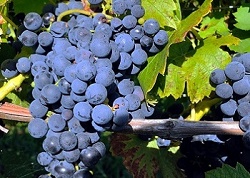Grape Anatomy

The Stem
The stem contains Bitter Tannins. It should be removed before pressing.
The Seeds (endocarp)
The seeds contain Oil and Tannins. They should not be crushed in the pressing.
(endocarp is a botanical term for the layer of the fruit which directly surrounds the seeds).
The Skin (exocarp)
The skin is full of aromas, and tannins (astringent taste), and pigments (colors).
The skin plays an important role when making red wines.
The color of a red wine comes from the skin. The flesh inside a grape is colorless.
The Pulp (mesocarp)
The pulp plays an important role for both the flavor and the acidity of a wine.
The pulp contains the sugars, acids, and water that are essential for the fermentation of the wine, and the aroma compounds that are essential for the flavor development.
Black Grapes

Red wines and Rosé wines are made from black grapes.
The skin of black grapes has a dark color (blue, violet, red).
Red wines get their color from the juice fermenting together with the skins.
White Grapes

White wines and Orange wines are made from white grapes.
The skin of white grapes has light color (yellow, green).
White wines get no color from the skins. The skins are pressed off before fermentation.
World Famous Wine Grapes
The world's most famous wine grapes are:
| Black Grapes | White Grapes |
 |

|
| Cabernet Sauvignon | Chardonnay |
| Pinot Noir | Sauvignon Blanc |
| Syrah/Shiraz | Riesling |
| Sangiovese | Pinot Grigio |
| Tempranillo | Pinot Blanc |
Vitis Vinifera
Vitis Vinifera (the grape vine) is the most cultivated and economically important fruit in the world.
Vitis vinifera is a flowering plant native to the Mediterranean region, Central Europe, and southwest Asia, from Morocco and Portugal in the south-west, to Germany in the north, Egypt in the south, and Iran and Georgia in the east.
Vitis vinifinera produces high quality grapes with good aromas. There are between 5.000 and 10.000 different varieties (Wikipedia), but only a few are of commercial significance for wine production.
The earliest evidence of wine is from the Caucasus region in Georgia (6000 BCE), in Persia (5000 BCE), and in Italy and Armenia (4000 BCE).
Cultivated Grapes (Cultivar)
Wild grapevine seeds naturally in humid riverbank forests.
Cultivated vines are not grown from seeds. They are spread from cuttings and selected via hybrids and clones. 2 years after planting, cultivated vines produce new grapes every year.
The lifespan of a grapevine can be over 100 years.
Riesling vineyard - Zell in Mosel
